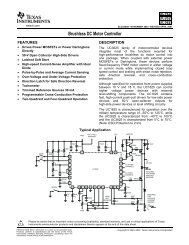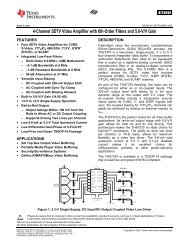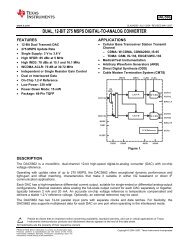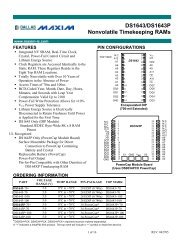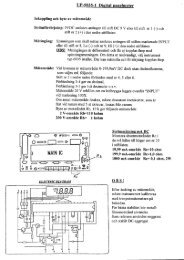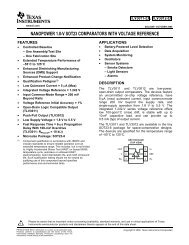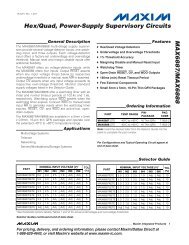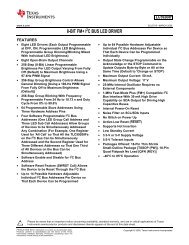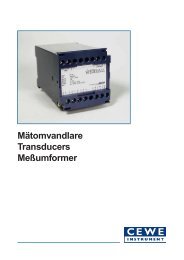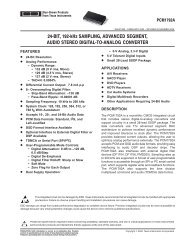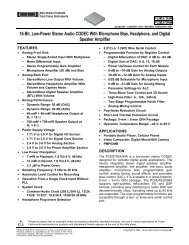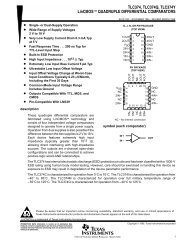Single-Chip Low Power RF Transceiver for Narrowband Systems ...
Single-Chip Low Power RF Transceiver for Narrowband Systems ...
Single-Chip Low Power RF Transceiver for Narrowband Systems ...
You also want an ePaper? Increase the reach of your titles
YUMPU automatically turns print PDFs into web optimized ePapers that Google loves.
19. Crystal Oscillator<br />
The recommended crystal frequency is<br />
14.7456 MHz, but any crystal frequency in<br />
the range 4 - 20 MHz can be used. Using<br />
a crystal frequency different from 14.7456<br />
MHz might in some applications give<br />
degraded per<strong>for</strong>mance. Refer to<br />
Application Note AN022 Crystal<br />
Frequency Selection <strong>for</strong> more details on<br />
the use of other crystal frequencies than<br />
14.7456 MHz.<br />
The crystal frequency is<br />
used as reference <strong>for</strong> the data rate (as<br />
well as other internal functions) and in the<br />
4 – 20 MHz range the frequencies 4.9152,<br />
7.3728, 9.8304, 12.2880, 14.7456,<br />
17.2032, 19.6608 MHz will give accurate<br />
data rates as shown in Table 17 and an IF<br />
frequency of 307.2 kHz. The crystal<br />
frequency will influence the programming<br />
of the CLOCK_A, CLOCK_B and MODEM<br />
registers.<br />
An external clock signal or the internal<br />
crystal oscillator can be used as main<br />
frequency reference. An external clock<br />
signal should be connected to XOSC_Q1,<br />
while XOSC_Q2 should be left open. The<br />
XOSC_BYPASS bit in the INTE<strong>RF</strong>ACE<br />
register should be set to ‘1’ when an<br />
external digital rail-to-rail clock signal is<br />
used. No DC block should be used then. A<br />
sine with smaller amplitude can also be<br />
used. A DC blocking capacitor must then<br />
be<br />
used (10 nF) and the XOSC_BYPASS<br />
bit in the INTE<strong>RF</strong>ACE<br />
register should be<br />
set to ‘0’. For input signal amplitude, see<br />
section 4.5 on page 12.<br />
Using the internal crystal oscillator, the<br />
crystal must be connected between the<br />
XOSC_Q1 and XOSC_Q2 pins. The<br />
oscillator is designed <strong>for</strong> parallel mode<br />
operation of the crystal. In addition,<br />
loading<br />
capacitors (C4 and C5) <strong>for</strong> the<br />
crystal are required. The loading<br />
capacitor<br />
values depend on the total load<br />
capacitance, CL, specified <strong>for</strong> the crystal.<br />
The total load capacitance seen between<br />
the crystal terminals should equal CL <strong>for</strong><br />
CC1021<br />
the crystal to oscillate at the specified<br />
frequency.<br />
1<br />
C L = + C<br />
1 1<br />
+<br />
C C<br />
XOSC_Q1 XOSC_Q2<br />
C4<br />
XTAL<br />
4<br />
5<br />
parasitic<br />
The parasitic capacitance is constituted by<br />
pin input capacitance and PCB stray<br />
capacitance. Total parasitic capacitance is<br />
typically 8 pF. A trimming capacitor may<br />
be placed across C5 <strong>for</strong> initial tuning if<br />
necessary.<br />
The crystal oscillator circuit is shown in<br />
Figure 33. Typical component values <strong>for</strong><br />
different values of CL are given in Table<br />
28.<br />
The crystal oscillator is amplitude<br />
regulated. This means that a high current<br />
is required to initiate the oscillations. When<br />
the amplitude builds up, the current is<br />
reduced to what is necessary to maintain<br />
approximately 600 mVpp amplitude. This<br />
ensures a fast start-up, keeps the drive<br />
level to a minimum and makes the<br />
oscillator insensitive to ESR variations. As<br />
long as the recommended load<br />
capacitance<br />
values are used,<br />
the ESR is<br />
not critical.<br />
The<br />
initial tolerance, temperature drift,<br />
aging and load pulling should be carefully<br />
specified in order to meet the required<br />
frequency accuracy in a certain<br />
application.<br />
By specifying the total<br />
®<br />
expected frequency accuracy in Smart<strong>RF</strong><br />
Studio together with data rate<br />
and<br />
frequency separation, the software will<br />
estimate<br />
the total bandwidth and compare<br />
to the available receiver channel filter<br />
bandwidth. The software will report any<br />
contradictions and a more accurate crystal<br />
will be recommended if required.<br />
C5<br />
Figure 33. Crystal oscillator circuit<br />
SWRS045B Page 58 of 89



